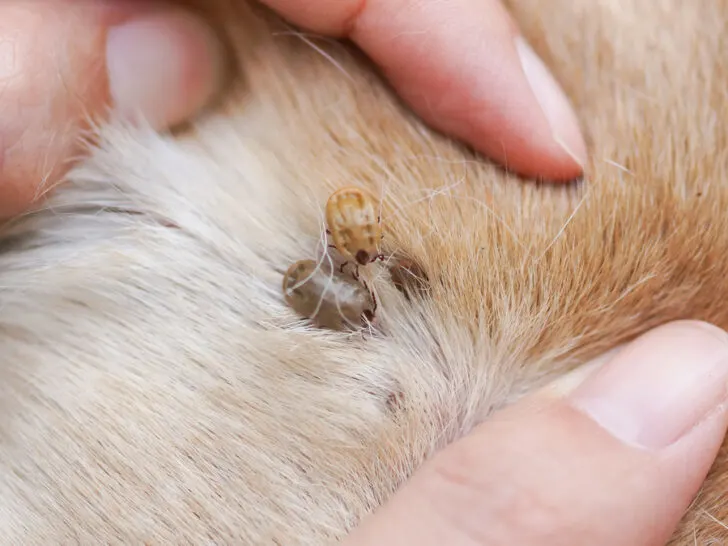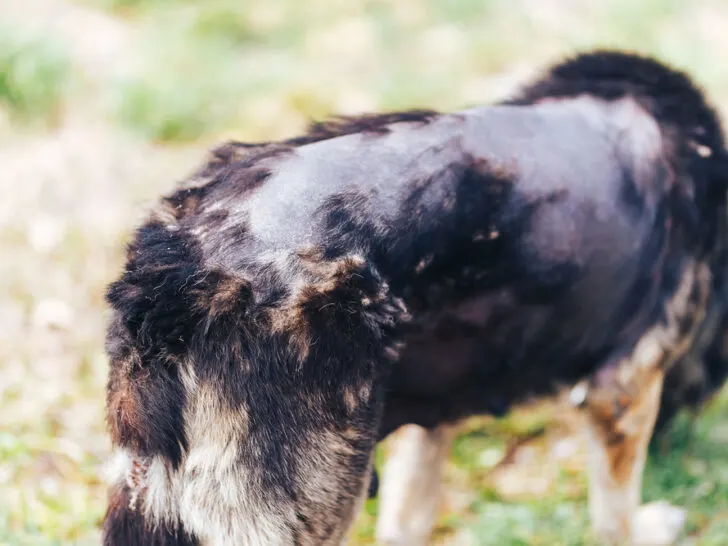Medically Reviewed by Dr. Majid Tanveer, DVM
Behind those thick and fluffy coats, our dogs have skin like us. Skin issues are the most common illnesses dogs can experience – varying in causes, infections, and treatments.
Are you familiar with the most commonly encountered skin issues? Do you know what causes them and how to address them?
Dog skin conditions can range from contact allergies and bacterial infections to more severe issues such as fungal infections, parasites, environmental allergies, and food sensitivities. Other common ailments include folliculitis, impetigo, ringworm, yeast infection, and infestations of ticks or fleas. Mange is also a frequent issue seen in dogs.
As a veterinarian and dog parent, I have encountered many issues and have done treatments for many skin problems. In this article, I have compiled the common skin conditions in dogs and the symptoms and potential underlying causes. Let’s get started!
What is the Normal Appearance of a Healthy Dog’s Skin?
Every dog is unique, including his individualized skin type. However, there are many common signs of a healthy coat:
- Depending on his genetic history and breed, your dog’s skin may be pink or black.
- Healthy skin should be free of allergic reactions, such as infection, itching, scaling, or crust. Moreover, it shouldn’t contain spots or other discolorations.
- The coat should be plush and glossy, free of any bare spots or fleas; he may shed throughout the year but more intensely in either summer or fall.
- Your dog’s coat should be healthy, glossy, and free from tangles, while his skin should feel soft to the touch.
8 Common Skin Problems in Dogs

Dogs can experience many minor skin issues, while others are more extreme. The most common types include:
1. Allergic Dermatitis
Allergic dermatitis is a common skin condition in dogs caused by:
- Environmental allergens
- Food allergens
It leaves them with itchy ears and skin infections. If left untreated, this uncomfortable disorder can be painful and frustrating for your dogs.
Allergens from the environment, such as pollen, grass, soil particles, mold spores, and house dust mites, can trigger hypersensitivity reactions in dogs.
Dogs often develop food allergies when their immune system mistakes a harmless substance as a threat and retaliates by causing an allergic reaction.
As a result of these irritants invading their bodies, dogs may manifest symptoms like itching or scratching on:
- Muzzle areas
- Paw pads
- Tail regions
They might also engage in behaviors like gnawing on body parts or licking excessively to soothe skin inflammation caused by allergies.
2. Parasitic Skin Problems
Dogs, unfortunately, provide a perfect habitat for parasites to thrive in, as their fur-covered bodies make them ideal hosts. Here are the most common ones found on our dogs:
Mange
Mange is a destructive skin disorder caused by mites commonly found on abandoned or uncared-for dogs, resulting in appalling lesions, itchy irritations, scabbing, and hair loss. This contagious disease has two kinds:
- Demodectic Mange
- Sarcoptic Mange
a. Demodectic Mange
Mites that naturally reside on dogs’ skin are responsible for causing Demodectic mange and can become more problematic if their immune systems are weakened.
Puppies, elderly dogs, or those with weakened immune systems are particularly at risk of demodectic mange. It is not contagious to humans.
Symptoms include:
- Isolated hair loss (mainly on the face)
- Redness
- Dandruff
- Hair loss – with or without itching
Treatment may be required for widespread cases.
b. Sarcoptic Mange
The scabies of canines, more commonly known as sarcoptic mange, is an extremely infectious condition both for dogs and humans, and it is caused by mites that burrow the skin. Humans may become hosts of the mites, but only briefly. Symptoms include:
- Profuse itching on the elbows, ear margins, belly, and ankles (hocks)
- Crusty bumps
- Hair loss
Sarcoptic mange causes intense itching, whereas demodectic mange usually does not.
Ectoparasitic Attacks

Ectoparasites are parasitic creatures that reside on your dog’s body and can cause severe health issues. It includes:
- Fleas
- Ticks
- Mites
In addition to being a nuisance, they are carriers of tapeworms and blood-borne illnesses, which can be detrimental if left untreated.
Dog mites are the prime source of irritation for our beloved dogs, and, unfortunately, they’re too small to be seen with the naked eye. These parasites feed off skin flakes, body oils, or blood.
3. Fungal Infections
When fungus grows unabated, invading the skin’s tissue, it results in a fungal infection. Two common types of fungi that affect dogs are:
- Ringworm
- Yeast infection
Ringworm
Contrary to popular belief, ringworm isn’t caused by worms at all. It is an infection brought on by a fungus known as dermatophytosis.
Characterized by its circular patches that usually appear on dogs’ heads, paws, ears, and forelegs, this aptly-named condition has been confusing for centuries.
Dermatophytes can gain access to your dog’s body through the following:
- Asymptomatically-carried microorganisms
- Direct contact with a symptomatic infected animal
- Simply coming into contact with spores in the environment
Freshly-shaven skins of your dogs are more susceptible to these fungi since they cannot penetrate healthy dermal layers.
Yeast Infections
Many bacteria and fungi inhabit a dog’s skin, but if his immune system functions properly, these organisms won’t cause any negative effects.
Excessive growth of Malassezia, a type of yeast found on dog skin, can create discomfort and cause irritations that lead to inflammation. These infections are not contagious but may result in hearing loss if the ears become heavily infected.
To promote optimal health for your dog, reducing his yeast or heavy metals intake is best while increasing the organic food in his diet.
4. Bacterial Infections
Although bacterial infections cannot be spread, their potential catalyst may be contagious. Listed below are some of the most prevalent bacterial skin diseases in dogs:
Folliculitis
Folliculitis occurs when the hair follicles become sore and inflamed. This affliction typically happens as a result of an infection with bacteria.
Superficial Bacterial Folliculitis is a common skin infection that can be easily identified in shorthaired dogs, causing:
- Scabs
- Bumps
- Sores
The most typical signs for dogs with lengthy fur are a lackluster coat, intense shedding, and scaly skin.
Folliculitis is prevalent with other dermal issues, such as injuries, mange, and allergies. Vets generally prescribe oral antibiotics, shampoos, or topical antibacterial applications to address the issue.
Impetigo
Young, prepubescent dogs subjected to unclean living environments are particularly susceptible to the highly contagious condition of canine impetigo.
This bacterial skin infection is characterized by non-follicular subcorneal pustules caused by a type of staphylococci known as coagulase-positive.
This condition results in painful, fluid-filled blisters that burst and scab over the hairless section of your dog’s abdomen. Fortunately, it’s not ordinarily severe and can be resolved with topical treatments; though uncommonly, it may continue to spread or linger.
Hot Spots
Red, inflamed patches of skin caused by persistent biting, licking, or scratching – usually on the neck, head, and base of the tail area – are known as hotspots. If neglected, hot spots can be incredibly agonizing and will quickly expand.
Flea bites frequently bring about these hotspots. However, any occurrence – that causes your dog to experience discomfort – can also cause hotspots and may include:
- Allergies
- Other parasites
- Contact dermatitis
- Mental stress, or boredom
- Ear and skin infections
Pyoderma
Pyoderma is a bacterial infection of the skin and hair follicles, characterized by red bumps, flaking skin, loss of fur, or discoloration. Its symptoms can be painful and disruptive to those affected.
Allergic dermatitides, such as flea and food allergies or seasonal atopy, cause pyoderma. However, it may also result from conditions that weaken the immune system:
- Thyroid issues
- Adrenal disorders
- Taking steroids
5. Alopecia

Alopecia, often called hair loss, can be thinning strands or bald spots. It may also cause inflammation and itching on the scalp. This condition is frequently triggered by ectoparasites like:
- Lice or mites
- Spider bites
- Skin infections
The licked area will become inflamed and raised during a prolonged period as it can never heal.
Treatment includes reducing licking, soothing discomfort, and tackling whatever cause could be responsible if one can be determined.
6. Acral Lick Granuloma
Acral lick dermatitis, more commonly called lick granuloma, is an irritating skin lesion caused by persistent and repetitive licking of the same area – usually at the front portion of a lower leg.
If left untreated, the irritation will persist and cause immense pain and itching, prompting a dog to lick one area incessantly.
To prevent this behavior, topical solutions with an unpleasant flavor or an Elizabethan collar should be used to discourage licking.
7. Skin Tumors
Many skin tumors, bumps, and cysts can manifest on the body. Whether these growths are benign or malignant is up for debate. Lipomas are frequently seen in more mature dogs.
Common in more senior dogs, lipomas are benign fatty tumors that appear as soft lumps under the skin. Result of an accumulation of fat cells, these growths can be unsightly but are usually harmless.
Regularly, your vet can take a sample (cells) from the bump via fine needle sampling and stain them to be observed under a microscope. By doing so, he can accurately determine if the bump on the skin is cancerous or non-cancerous.
8. Immune Disorders
Just like humans, dogs are vulnerable to auto-immune diseases such as pemphigus. These illnesses can lead to a wide range of skin issues, including:
- Dandruff
- Ulcers
- Inflammation
- Hair loss
- Thickened paw pads
This health issue can resemble bacterial skin infections, yet it is not responsive to antibiotics and usually does not provoke itching.
How to Treat Your Dog’s Skin Problems?
Dealing with skin issues brought on by allergies in your dog can be irritating, but there are plenty of ways to end his discomfort:
- While over-the-counter shampoos and oils (like Coconut oil) can offer short-term relief, treating the underlying issue for long-lasting results is essential.
- Antihistamines may provide minimal relief to an allergic itch, yet steroids can be used with the possibility of adverse effects such as increased urination, thirst, and weight gain. In extreme cases, an unhealthy dog can develop aggressive tendencies.
Tips to Prevent Skin Problems in Your Dog
To avoid skin problems in your dog, it is important to provide him with regular care and attention. Here are a few tips for doing so:
- Keep your dog’s coat clean and brushed regularly to reduce dirt, dandruff, and other debris build-ups that irritate the skin.
- Give your dog regular physical activity and a nutritious diet for optimal blood flow and skin health.
- For healthy, glowing skin, try refraining from feeding your dog table scraps, as it could throw off his nutrient balance.
- Stay ahead of flea allergies by regularly administering flea treatments.
- Keep watch for any indicators of infection or inflammation, like crusting, redness, and itching.
- In hot weather, keeping your dog cool and shaded is essential. This will help protect his skin from any possible irritation or discomfort.
- Steer clear of heavy soaps that can strip away the natural oils, which act as a barrier against outside irritants.
- Minimizing exposure to environmental pollutants, like dust and pollen, can help reduce the risk of developing skin allergies that irritate.
Pet Care Tip: Check out this video on a dog’s skin infections. It will show you how to treat his skin infections properly with different home remedies.
Frequently Asked Questions
What Is a Natural Anti-fungal for Dogs?
Natural dog antifungals include pau d’arco, thyme, undecylenic acid, rosemary, oregano oil, and caprylic acid. These can help restore natural flora balance and eliminate fungal overgrowth. Adding immune boosters to your dog’s diet is also recommended.
Can I Rub Coconut Oil on My Dog?
Coconut oil is a great way to moisturize and freshen your dog’s coat. Rub a small amount between your hands, then massage it onto his fur and skin. You’ll be amazed at how soft his coat will feel! Plus, it can help prevent dryness or flaking.
What Are the Most Effective At-Home Treatments for My Dog’s Skin?
Green tea, chamomile, and calendula are ideal ingredients for itchy skin to add to a dog’s bath. These natural remedies soothe and cool irritated patches of skin while reducing inflammation. A soothing soak can help keep hot, itchy areas from getting rubbed raw.
